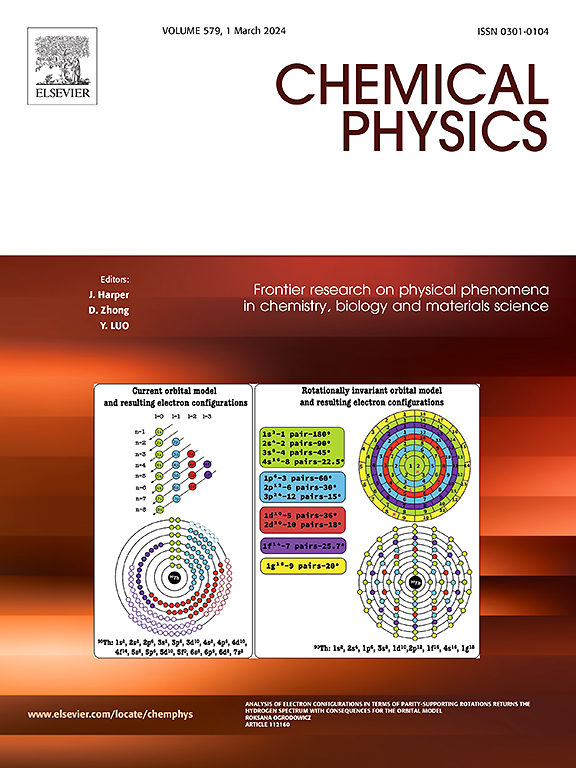Extrusion of carbon with SON in heterocycles for enhanced static and dynamic hyperpolarizabilities and light harvesting efficiencies
IF 2
3区 化学
Q4 CHEMISTRY, PHYSICAL
引用次数: 0
Abstract
The current study investigates the electronic, spectroscopic, and nonlinear optical (NLO) properties of cyclic pyrrole/furan/thiophene (CPFT) compounds and their derivatives using density functional theory (DFT) calculations. The electronic and absorption characteristics were analyzed using four methods—B3LYP-D3, M06-2×, CAM-B3LYP, and ωB97XD—with the 6-311G (d, p) basis set. Molecular geometries were optimized, and frontier molecular orbital (FMO) analysis was performed to understand structure-property relationships. Compound 1d exhibited the smallest HOMO-LUMO gap (3.79 eV) and the highest NLO response due to the presence of an electron-donating -NH₂ group. Molecular electrostatic potential (MEP) analysis identified electron-rich (nucleophilic) and electron-deficient (electrophilic) regions within the molecules. The introduction of reducing and oxidizing agents significantly influenced the total NLO polarizability. Dipole moment (μ), linear polarizability (α₀), static and dynamic second-order NLO polarizability (β) and light harvesting efficiencies were calculated for all compounds. 1d displayed the largest static second-order NLO response (12,846 a.u.), approximately 1252 times greater than other derivatives and higher LHE of 97 %. Electron localization function (ELF-π) and localized orbital locator (LOL-π) analyses confirmed enhanced electron delocalization in the series-1 compounds. Time-dependent DFT (TD-DFT) calculations determined excitation energies, oscillator strengths, and absorption wavelengths. The absorption spectra showed maximum peaks between 423 and 500 nm for series-1 as compared to series-2 and series-3, supporting strong NLO activity. Frequency-dependent hyperpolarizability at longer wavelengths (1460 and 1907 nm) further enhanced NLO responses. Natural bond orbital (NBO) analysis revealed stabilizing hyperconjugative interactions. These findings demonstrate that CPFT derivatives are promising candidates for optoelectronic and NLO applications, providing a foundation for designing advanced functional materials.

在杂环中挤压含SON的碳以增强静态和动态超极化率和光收集效率
本研究利用密度泛函理论(DFT)计算研究了环吡咯/呋喃/噻吩(CPFT)化合物及其衍生物的电子、光谱和非线性光学(NLO)性质。以6-311G (d, p)为基准,采用b3lyp - d3、m06 - 2x、CAM-B3LYP和ω b97xd四种方法分析了其电子和吸收特性。通过分子几何结构优化和前沿分子轨道(FMO)分析来了解结构-性能关系。化合物1d具有最小的HOMO-LUMO隙(3.79 eV)和最高的NLO响应,这是由于给电子- nh2基团的存在。分子静电电位(MEP)分析确定了分子内富电子(亲核)和缺电子(亲电)区域。还原剂和氧化剂的加入对NLO总极化率有显著影响。计算了所有化合物的偶极矩(μ)、线性极化率(α 0)、静态和动态二阶NLO极化率(β)和光收集效率。1d显示出最大的静态二阶NLO响应(12,846 a.u),大约是其他导数的1252倍,LHE高达97%。电子定位函数(ELF-π)和定域轨道定位器(LOL-π)分析证实了1系化合物的电子离域增强。时间相关的DFT (TD-DFT)计算确定激发能,振荡器强度和吸收波长。与系列2和系列3相比,系列1的最大吸收峰在423 ~ 500 nm之间,表明系列1具有较强的NLO活性。在更长的波长(1460 nm和1907 nm)下,频率相关的超偏振性进一步增强了NLO响应。自然键轨道(NBO)分析显示了稳定的超共轭相互作用。这些发现表明CPFT衍生物是光电和NLO应用的有希望的候选者,为设计先进的功能材料提供了基础。
本文章由计算机程序翻译,如有差异,请以英文原文为准。
求助全文
约1分钟内获得全文
求助全文
来源期刊

Chemical Physics
化学-物理:原子、分子和化学物理
CiteScore
4.60
自引率
4.30%
发文量
278
审稿时长
39 days
期刊介绍:
Chemical Physics publishes experimental and theoretical papers on all aspects of chemical physics. In this journal, experiments are related to theory, and in turn theoretical papers are related to present or future experiments. Subjects covered include: spectroscopy and molecular structure, interacting systems, relaxation phenomena, biological systems, materials, fundamental problems in molecular reactivity, molecular quantum theory and statistical mechanics. Computational chemistry studies of routine character are not appropriate for this journal.
 求助内容:
求助内容: 应助结果提醒方式:
应助结果提醒方式:


